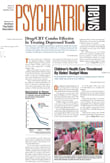Nearly 27,000 attendees flocked to the Big Apple to be a part of APA's 2004 Annual Meeting last May, making it the most well-attended meeting in APA history, according to a report issued by APA's Department of Continuing Medical Education (CME).
Kathleen Debenham, director of that department, prepared the report.
Attendance levels far surpassed those at the 2003 Annual Meeting in San Francisco, which drew roughly 21,000 attendees.
“Ninety-eight percent of respondents to the general evaluation believed the quality of the annual meeting sessions to be excellent,” the report pointed out, and 99 percent of respondents felt that the sessions met their educational objectives.
According to the report, “The meeting's strong scientific program was a critical element in drawing members and other mental health professionals” to the meeting.
The meeting had an international flair— a record-setting 8,974 international psychiatrists attended the meeting, and they comprised 42 percent of meeting registrants.
International attendees represented 96 countries. As usual, Canada had the highest number of registrants from outside the United States, at 1,387, and the second highest number of international registrants came from Spain (965).
Other countries that boasted high attendance rates were the United Kingdom (817), the Netherlands (555), France (460), Mexico (326), Germany (303), Sweden (276), Italy (234), Denmark (232), Brazil (210), Portugal (198), Switzerland (183), and Greece (166).
More than 325 reporters and other media representatives from around the world covered the sessions, according to the report, and news from the annual meeting landed on the pages of the New York Times, Washington Post, and Wall Street Journal.
Once exhibitors, press, and staff were subtracted from the total attendance, data show that 21,376 attendees registered to attend the scientific sessions—the highest number on record.
APA continued to use a variety of strategies to expand its monitoring of industry-supported symposia [ISS] to ensure that the material presented was balanced and unbiased.
Since 1998 APA has used the ISS Resident Monitor Program for both the annual meeting and the Institute on Psychiatric Services, held in October each year.
Residents in psychiatry attend the ISS and, using guidelines developed by APA's Department of CME and the Committee on Commercial Support, monitor the following: balance in each presentation, disclosure of conflicts of interest by faculty, use of generic/brand names, disclosure of any discussion of unapproved or investigational uses, and bias toward the supporting-company's products.
The results of the evaluation of those symposia indicated that APA's oversight measures were effective, since overwhelming majorities of respondents (95 percent) agreed that “multiple viewpoints” and“ an unbiased view of the topic” were presented in the sessions. In addition, 97 percent of respondents thought that the ISS would help them improve the effectiveness of their practices.
Approximately 86 percent of the 6,930 annual meeting evaluation respondents identified themselves as psychiatrists, and 4 percent of those respondents (277) were residents.
Nonphysician health professionals made up a relatively small portion of the meeting registrants: 1.4 percent were psychologists, 1 percent were social workers, and 1.2 percent were nurses.
Around 81 percent of evaluation respondents characterized their primary professional activity as patient care, followed by research (6 percent), administration, and teaching (5 percent each).
Respondents also were asked to identify their primary work setting, and the percentage of respondents indicating “solo or group private practice” was 32 percent.
Other settings included university hospitals (15 percent); general hospitals (15 percent); psychiatric hospitals (13 percent); community mental health centers (7 percent); state/local facilities (6 percent); VA facilities (4 percent); and staff-model HMOs (1 percent).
Participants were asked to name topics they would like to learn more about at subsequent meetings. They expressed interest in more sessions on psychotherapy of all types, clinical information relating to child and adolescent psychiatry, and information about new medications, among others.
When surveyed on some of the positive and negative aspects of the meeting, some respondents expressed frustration over the fact that meeting sessions were held in a number of widely separated locations, which, given the New York traffic, made it difficult to reach some sessions in a timely way.
The majority of the respondents praised the meeting. As one registrant put it, “This meeting was stimulating for me. I have a renewed interest in science, psychotherapy, and the field as a whole....”
About 73 percent of evaluation respondents indicated they plan to attend next year's annual meeting.
The evaluation was based on responses submitted on the General Evaluation Form, which was included with registration materials, distributed on site, and mailed to registrants after the meeting. The survey could also be completed at computer terminals in the APA Resource Center and at kiosks in the Exhibit Hall, and for the first time, through an online survey program after the meeting.
Next year's meeting will be held May 21 to 26 in Atlanta. ▪
